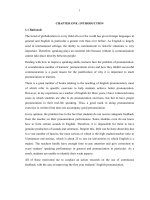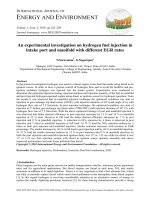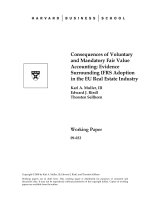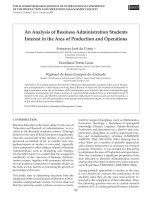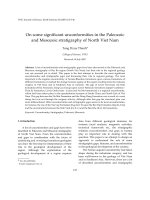Financial performance, dividend payment and firm value an exploratory research on Vietnam listed firms in the food and drink industry
Bạn đang xem bản rút gọn của tài liệu. Xem và tải ngay bản đầy đủ của tài liệu tại đây (195.22 KB, 11 trang )
VNU Journal of Science: Economics and Business, Vol. 32, No. 2 (2016) 47-57
Financial Performance, Dividend Payment and Firm Value
An Exploratory Research on Vietnam Listed Firms
in the Food and Drink Industry
Ngo Thu Giang*, Dang Anh Tuan
School of Economics and Management,
Hanoi University of Science and Technology, 1 Dai Co Viet, Hanoi, Vietnam
Abstract
This research studies the relationships between dividend payment and the market value of listed firms
in the food and drink industry in the period 2010 to 2014 in Vietnam. The research finds empirically
applicable factors in corporate finance and the management of stock listings in the stock exchange. The
research develops an exploratory model reflecting the market value of the firms in the food and drink
industry in the Vietnamese stock market in relation to their financial performance and dividend payments.
The research also finds that in the food and drink industry in Vietnam, firms will be more attractive in the
stock exchange if they pay dividends in cash, achieve high gross margins, and mobilize a low debt ratio at a
low mobilization cost.
Received 16 February 2016, revised 9 June 2016, accepted 28 June 2016
Keywords: Financial performance, dividend payment, market value, listed firm, beverage and food industry,
Vietnamese stock exchange.
1. Introduction *
strategies, managerial countermeasures and
investor relation policies.
In terms of financial management, we
would like to know what the role of financial
management is in drawing the attention of
investors and how it can do that. To answer
these questions, the research reviews
theoretical frameworks to develop measuring
criteria for financial activities. The research
also studies previous researches to find out
the current status of studies on financial
performance in general, and dividend
payment in particular, and their impacts on
the market value of firms in stock exchanges.
Practically, based on what is achieved by
reviewing theoretical frameworks and previous
research, this research aims to develop
The Vietnamese stock exchange is an
emerging market which was developed in 2000,
and has officially operated with two official
trading centers namely, HOSE (Hochiminh
Stock Exchange) and HNX (Hanoi Stock
Exchange) since 2005. The stock exchange is
evaluated as an efficient channel for funding the
mobilizing of Vietnamese joint stock
companies. To draw the attention of investors
in a highly competitive environment, listed
companies have to develop suitable business
_______
*
Corresponding author. Tel.: 84-438683662
E-mail:
47
48
N.T. Giang, D.A. Tuan / VNU Journal of Science: Economics and Business, Vol. 32, No. 2 (2016) 47-57
exploratory findings to clarify these concerns in
the beverage and food industry by testing relation
of financial performance, dividend payment and
firm value with empirical data collected from
firms in the industry listed in the Vietnamese
Stock Exchange.
2.
Financial
performance,
payment and firm value
dividend
In order to survive and develop,
companies have to satisfy their customers by
providing good quality of products or/and
services. All companies have to start up by
setting adequate assets. The companies
should clarify (1) which assets should be
invested, and (2) how to invest them.
Every decision that a business makes has
financial implications, and any decision which
affects the finances of a business is a corporate
finance decision. The financial manager should
make three types of financial decisions: (1)
Investment decisions: “Where do they invest
the scarce resources of their business? And
what makes a good investment?” (2) Finance
decisions: “Where do they raise funds for these
investments? What mix of owner’s money
(equity) or borrowed money (debt) do they
use?” and (3) Profit distribution decisions:
“How much funds should be reinvested in the
business and how much should be returned to
the owners?” While making these decisions,
corporate finance is single-minded about the
ultimate objective, which is assumed to be
maximizing the value of the business.
At the end of fiscal years, the results of
financial management in corporations with
other business activities are reflected on firms’
financial statements and measured by financial
indicators. Theoretically, the results of the
investment of assets and usage are reflected in
asset structure, current asset turnovers,
productivity of long term assets, return on total
assets and reinvestment ratio. Besides, the
performance of financing activities are
measured by the structure of fund mobilization;
the cost of capital; and return on capital. And
income distribution activities are measured,
firstly, by cost-covering as margin ratios.
[financial analysis]. After covering all costs
arising from the operation, firms have to decide
how to, and how much return should flow to
shareholders. Theoretically, the income
distribution can be divided into two subdecisions: “cost covering decisions” and
“dividend payment” decisions.
In the stock market, the financial decision
to which investors pay much attention is the
dividend decision. The decision reflects
comprehensively
the
firm’s
financial
performance; the firm’s intention in developing
investor relationships, and its sustainability in
the stock market. Generally, dividend payment
has been an issue of interest in financial
literature since joint stock companies came into
existence. Dividends are commonly defined as
the distribution of earnings (past or present) in
real assets among the shareholders of the firm
in proportion to their ownership. Dividend
payment connotes to the payout policy, which
managers pursue in deciding the size and
pattern of cash distribution to shareholders over
time [5].
Management’s
primary
goal
is
shareholders’ wealth maximization, which
translates into maximizing the market value of
the company. Market value is also commonly
used to refer to the market capitalization of a
publicly-traded company, and is obtained by
multiplying the number of its outstanding
shares by the current share price [2].
3. Literature review
A lot of research has been executed on
financial performance, dividend payments,
market value and their inter-relations. Several
researches have focused on the relationship
between financial decisions of individuals to
market values, while others have considered
directly the relationship between dividend
payments and market values.
Considering the impacts of investment
decisions on market value, empirical evidence
in the Tehran Stock Exchange from the year
2006 to 2010 proved that there is a significant
relation between working capital and the market
N.T. Giang, D.A. Tuan / VNU Journal of Science: Economics and Business, Vol. 32, No. 2 (2016) 47-57
value of listed firms [8]. In addition, investment
in tangibly fixed assets such as factories,
equipment and intangible assets also has a
significant and positive impact on listed firms
which was proved by the data of 140 listed
firms in the Spanish Stock Exchange from the
year 1991 to 1997 [9].
Regarding financing decisions, the previous
researchers applied the ratio of capital structure
to measure the financing performance of the
listed firms in Nigeria and Bangladesh in the
period 2005-2009. The results showed that
firms with high debt have a higher market value
[10, 11]. However, according to theory, firms
can only take advantage of financial leverage if
they operate assets much more efficiently than
the average operation efficiency of the
economy, which is reflected in the nominal
interest rate of loans provided by the banks.
Hence, it is not reasonable if we measure
financing decisions with structural ratios. We
need to take the cost of mobilized funds into
consideration as well.
Considering income distribution decisions,
empirical researches which were implemented
with 38 listed firms in the Indonesian Stock
Exchange in the period from 2010 to 2012 [12];
and for 27 industries in the period from 1977 to
2008, [13] applied margin ratios to test the
relationship
between
the
cost-covering
capability and market value. The results showed
that there were negative but not significant
relations between cost-covering in income
distribution decisions and market value.
Considering dividend payment in profit
distribution decisions, the founder of this
research field is Miller and Modigliani (1961)
with regard to evaluating the correlation
between dividend payments of a listed company
and its market value. The dividend payment is
measured by dividend yield and dividend
payout ratios. Tests were applied for developed
and emerging stock exchanges such as the
Dhaka Stock Exchange in the period from 2007
to 2011 [1]; and in the Malaysian Stock
Exchange in the period from 2005 to 2010 [5];
and in the Indian National Stock Exchange [5];
and in different industries such as construction,
information technology, and the service sectors.
The level of impact is uncertain. The market
49
price of stock in developed stock exchanges
reacts remarkably with the announcement and
exercise of dividend payments while the
reaction in emerging stock exchanges is not
so significant. One reason found was that the
dividend payment in emerging stock
exchanges is not attractive and is lower than
investors’ expectations.
The models implemented in foreign stock
exchanges are summarized in Table 1.
Local researchers also pay serious attention
to the execution of the market by implementing
a lot of research on market price reactions under
the operation of listed companies, particularly
on change of the market value or market price
of listed stock when the company applies
different dividend payments to investors.
Vu Van La (2013), Phung Tat Huu (2013)
have studied the impact of dividend payments
on the stock price of listed companies in the
Vietnamese Stock Exchange [6], and
particularly in the Hochiminh Stock Exchange
[4] in the period 2007 to 2013. In addition to
the variables of dividends paid as independent
variables and retained earning ratio, the
researches also considered earnings per share,
and return on equity as supplemental
independent variables in a multiple regression
model with dependent variables as the market
price of listed stocks. The researchers have
taken samples of listed companies from
different industries while neglecting the impact
of industrial characteristics in making dividend
payments. The result achieved from the local
researches shows that investors are interested in
profit after tax, and dividends paid while their
reactions to market price are not clear with the
declaration of dividend payout ratio.
Unreasonable ways of measuring are
inherent in the above research (Table 1) in that
the researchers applied profit after tax and
earning per share as independent variables.
They did this because the profit after tax of
each listed firm depends on market conditions
in each period and its own industrial
characteristics. Academically, the “earning per
share” variable has a close correlation with
“retained earning ratio”, and “profit after tax”.
Considering all mentioned variables in one
model may lead to unsuitable results.
50
N.T. Giang, D.A. Tuan / VNU Journal of Science: Economics and Business, Vol. 32, No. 2 (2016) 47-57
Table 1: List of papers studied in foreign stock exchanges
Paper titles
Authors/
Publications
Independent
variables
Abbasali
Pouraghajan, Milad
Emamgholipourarchi;
International Journal
Of Business And
Social Science, vol. 3
no. 10 [special issue may 2012
Roa, return on
invested
capital, cash
conversion
cycle, current
ratio, current
liabilities/total
asset; total
debts/total asset
Dependent
variable
Sample
Result
Market
value
Companies
listed in the
Tehran
stock
exchange
during the
years 2006
to 2010
No
relation
with
market
value
Market
value
140
Spanish
listed
companies
for the
1991–1997
period,
Market
price per
share
39 nonfinancial
listed
companies
for the
period of
2005-2009
High
financial
leverage
leads to
high
market
value
Share price
Dhaka
Stock
Exchange
(dse) and
Chittagong
Stock
Exchange
(cse) of
Bangladesh
High
leverage
leads to
high
market
value
Investment Decision
Impact of Working
Capital Management
On Profitability and
Market Evaluation:
Evidence from the
Tehran Stock
Exchange
Félix j. LópezIturriaga∗ And Juan
Ownership Structure,
Corporate Value and
Firm Investment: A
Simultaneous
Equations Analysis
of Spanish
Companies
Antonio RodríguezSanz, Journal of
Management And
Governance 5: 179–
204, 2001.
Tobin’s q
theory of
investment:
invp, invin,
ownership
structure
Financing Decision
Corporate Capital
Structure and
Corporate Market
Value: Empirical
Evidence from
Nigeria
Impact of Capital
Structure on Firm’s
Value: Evidence
from Bangladesh
Oboh Sankay
Collins1, Isa Envulu
Filibus2 & Adekoya
Adeleke Clement,
International Journal
of Economics and
Finance; vol. 4, no.
12; 2012
Debt/equity;
debt to capital,
size,
Anup Chowdhury,
Suman Paul
Chowdhury, Beh Business and
Economic Horizons
volume 3 | issue 3 |
October 2010 |pp.
111-122
Debt-equity
structure,
public
ownership,
profitability,
dividend
payout, asset,
size, operation
efficiency,
growth rate,
liquidity,
business risk
N.T. Giang, D.A. Tuan / VNU Journal of Science: Economics and Business, Vol. 32, No. 2 (2016) 47-57
51
Profit distribution decision
Capacity
Constraints, Profit
Margins and Stock
Returns
Dividend Policy and
its Impact on Stock
Price – a Study on
Commercial Banks
Listed in the Dhaka
Stock Exchange
The Impact Of
Dividend Policy On
The Share Price
Volatility: Malaysian
Construction And
Material Companies.
g
Bjorn n. Jorgensen,
Gil Sadka, Jing Li,
11-9-2009, Carnegie
Mellon University
Research Showcase
@ Cmu
Abdullah Al Masum,
Global Disclosure Of
Economics And
Business, Volume 3,
No 1 (2014) Issn
2305-9168
Zuriawati Zakaria¹,
Joriah Muhammad²
And Abdul Hadi
Zulkifli3;
International Journal
Of Economics And
Management
Sciences, Vol. 2, No.
5, 2012, pp. 01-08
Earnings per
share, return on
equity,
retention ratio,
dividend yield
Dividend yield
(dy), dividend
payout
ratio(dpr)
4. Research methodology
4.1. Variables and model
The literature review confirms with
confidence that there are correlations among the
financial decisions of firms. Considering
measures of financial performance and dividend
payment as independent variables in testing the
relation between financial decisions and firm
market value, is not reliable. Hence, firstly,
based on data of listed firms in the beverage
and food industry in Vietnam, we would like
to test correlations among the variables,
measuring firms’ financial performance and
dividends to clarify correlations among
independent variables. Then, we will develop
and adjust an exploratory model to reflect the
relationship between financial performance,
dividend payment and market value for listed
firms in the industry.
A conceptual model of our research is
presented in Figure 1.
Stock return
Stock price
Stock price
volatility
26
industries,
1977-2008
Dhaka
Stock
Exchange,
five years
from 2007
– 2011
Positive
and not
remarkab
le
relation
Positive
relation
2005 until
2010
4.2. Measurement of financial performance,
dividend payment and market value
Variables are categorized and listed in the
following tables. The tables also show the
variables’ codes and measurements. Based on
the measurements, the research collects
respective data from the research population
which is mentioned in the following parts.
4.3. Research sample and data collection
The research uses the sample of all firms in
the food and drink industry and listed in the
Vietnamese Stock Market since the year 2010
when the Vietnamese stock market was in good
listing conditions in a transparent environment.
In such conditions, it is assumed that stock
market
prices
reflect
adequately
the
performance activities of the listed companies.
However, from 2012 to 2014, four of the
selected firms in the sample were blocked and
stopped being listed in the market. The total
number of firms studied in the research is 17
firms, as shown in the following table. All
information related to dividend payments and
the market capitalization of selected firms was
collected from the year 2010 to 2014.
52
N.T. Giang, D.A. Tuan / VNU Journal of Science: Economics and Business, Vol. 32, No. 2 (2016) 47-57
g
CORPORATE FINANCE
Investment decision
Financing decision
MARKET VALUE
Capitalization value
Income distribution
decision/ cost covering (1)
Profit distribution decision/
dividend payment (2)
Figure 1: Conceptual framework.
Table 2: Variables and measurements
No
Variables
Investment Decision
1.1
Investment structure
Reinvestment
1.2
1.3
Current asset turnover
Non current asset
turnover
Total asset turnover and
1.5
return
Financing decisions
2.1
Structure
1.4
2.2
Cost of funds
2.3
Fund returns
Code
Measurement
CURASSET
REINVEST
RECEIVABLES,
INVENTORY
FIXASSETPRO
Current asset to total asset ratio
Reinvestment of current asset and non current
asset to total of profit after tax and interest
Total revenue to averaged Account receivables;
Total revenue to averaged inventory
Total revenue to averaged noncurrent assets
TOASSETPRO,
ROA
Total revenue to averaged total assets; return on
total asset
DEBTEQUITY
DEBT COST,
EQUITY COST
ROC, ROE
Debt to equity ratio
Interest to averaged liabilities; Cost of equity
(Calculated by CAPM)
After tax profit to averaged total capital; After
tax profit to averaged equity
Income distribution decision/ cost covering
3.1
Gross margin
GRMARGIN
3.2
Operation margin
OPEMARGIN
3.3
Profit margin
PROMARGIN
Profit distribution decision/ dividend payment
4.1
Dividend paid
DIVPAR
4.2
Dividend payout
Market value
5.1
Market value
DIVPOUT
MVS
Gross profit to revenue
Before tax profit to revenue
After tax profit to revenue
Fraction of cash dividend payment for one stock
in one year and per value of stock
Ratio of dividend per share to earnings per share
Ratio of capitalized value of listed firm per share
to per value of stock
N.T. Giang, D.A. Tuan / VNU Journal of Science: Economics and Business, Vol. 32, No. 2 (2016) 47-57
53
Table 3: List of selected firms in the research sample
No
Code
Stock Exchange
Name
1
ACL
HSX
CL - FISH CORPORATION
2
AGF
HSX
AGIFISH CO.
3
ANV
HSX
NAVICO
4
BLF
HNX
BAC LIEU FIS
5
CAN
HNX
HA LONG CANFOCO
6
CMX
HSX
CAMIMEX
7
KDC
HSX
KIDO CORPORATION
8
LSS
HSX
LASUCO
9
MSN
HSX
MASAN GROUP CORPORATION
10
NGC
HNX
NGOPREXCO
11
NHS
HSX
NHS
12
SAF
HNX
SAFOCO
13
SEC
HSX
SEC
14
SJ1
HNX
SEAJOCO VIET NAM
15
SSC
HSX
SSC
16
TS4
HSX
SEAPRIEXCO NO 4
17
VNH
HSX
VISEA CORPORATION
Source: Websites of State Securities Committee - www.ssc.gov.vn; 2015.
Data was collected from the annual
financial statements of studied firms and annual
capitalization value. Even though we selected
the population of listed companies in the
industry, the number of studied cases is still
limited. Hence, the research is considered as an
exploratory study for the beverage and food
industry in Vietnam.
5. Model testing
As mentioned above, in the 1st step, we
apply the empirical data collected from the
population for clarifying correlations among
independent variables which have been used in
previous researches and developed from
theoretical review. In the 2nd step, based on the
reviewing correlations as tested, we develop a
reasonable model which reflects significantly
the relationship between financial performance,
dividend payment and market value for listed
firms in the industry.
The correlation table shows that most variables
of investment decision, financing decision and
income distribution decision/ cost covering have
significant relationships with each other. Only
several variables have relatively dependent
variables with each other. These are,
“reinvestment”, “asset turnovers” and “asset
return”; “financing variables”; and “margin ratios”.
Considering the correlation between
financial performance and dividend payments,
variables of financial performance are
considered as relatively independent of
54
N.T. Giang, D.A. Tuan / VNU Journal of Science: Economics and Business, Vol. 32, No. 2 (2016) 47-57
dividend payment’s variables if their
coefficients are much lower than 0.5; and/or not
significant at the levels of 0.01 and 0.05. The
variables will be added to the model. The
correlation table also shows that it is necessary
to consider that not all variables of financial
performance accompany dividend payment’s
variables in the model, reflecting the
relationship between financial performance,
dividend payment and market value.
In the 2nd step, an optimal model is
developed and tested to reflect the relationship.
Variables to be considered as independent
variables in the model are: “currasset”,
“reinvest”,
“inventory”,
“receivables”,
“fixassetpro”,
“debtcap”,
“debtcost”,
“equitycost”,
“grmargin”,
“opemargin”,
“promargin”, “divpar” and “divpout”.
5.1. Model testing
The conceptual model is tested as two
alternatives. In the first considered alternative,
all selected variables mentioned in item 5.1 are
tested and the result is shown in the column
“Model 1” in the following table. In the second
alternative,
the
research
eliminates
unreasonable variables in order to find the
optimal function reflecting the relationship
which we would like to investigate in the
context of listed firms in the beverage and food
industry in the Vietnamese Stock Exchange.
The result of the second alternative is reflected
in the column “Model 2” in the following table.
Correlations of independent variables
Model 1 considered all variables developed
in the conceptual framework, except several
variables which have a close and significant
correlation with other independent variables as
ROA and ROE. With the p value almost 0 and
the adjusted R squared of 0.646, we are confident
to confirm that there is a significant impact of
financial performance and dividend payment on
the firm value. And 64.6 per cent of the “market
value” variable is measured by variables of
financial performance and dividend payment. In
detail, the variables which have a remarkable
impact on the firm market value are margin ratios
and debt structure.
Table 4: Variables’ correlation
55
N.T. Giang, D.A. Tuan / VNU Journal of Science: Economics and Business, Vol. 32, No. 2 (2016) 47-57
Table 5: Model testing
Dependent Variable: MVS
Method: Least Squares
Variable
C
Model 1
Coefficient
Prob.
Model 2
Coefficient
2.607101
Prob.
0.0012
1.797485
0.612821
0.235029
0.735546
REINVEST
-0.06384
0.741368
INVENTORY
0.152416
0.117781
RECEIVABLE
-0.00564
0.067273
FIXASSETPRO
0.081419
0.805164
ASSETPRO
-1.3303
0.244055
DEBTCAP
-17.3455
0.019991
-1.959332
0.0624
DEBTCOST
-1.14146
0.728468
-0.183646
0.0000
EQUITYCOST
5.546142
0.000159
GRMARGIN
48.11681
0.000801
OPEMARGIN
-49.867
0.000522
0.046429
0.0064
PROMARGIN
-1.01423
0.660419
DIVPAR
-0.14001
0.432570
5.511165
0.006
DIVPOUT
-0.15758
0.500075
CURASSET
R-squared
0.715
0.691776
Adj.R-squared
0.646
0.663755
10.405
24.68829
0.000
0.00000
F-statistic
Prob(F-statistic)
e
Compared with previous researches which
were implemented with a portfolio of different
industries, the result achieved in Model 1
reflects an opposite impact of margin ratios
on market value. It is clear that the
characteristics of an industry are important
factors that should be considered in doing
research on financial management.
To develop an optimal function reflecting
the
relationship
between
financial
performance, dividend payment and the
market value of listed firms in Vietnam’s
beverage and food industry, Model 2 is
developed by reviewing and eliminating
unreasonable variables in Model 1. The test
result of Model 2 is shown in the above table.
The p value of 0 shows that the proposed
model is reliable, applicable and significant in
the Vietnamese stock market at a 0 level. The
independent variables explain 66.4 per cent of
the dependent variable. The optimal function
reflecting the relationship between dividend
payment, capital structure and market value is
formed as follows:
MVS = 2.607 + 5.511*DIVPAR +
0.046*GRMARGIN − 1.959*DEBTCAP −
0.183*DEBTCOST
The function reflects that in Vietnam’s
beverage and food industry, the gross margin
and dividend payment have a positive impact
on the market value of a firm. However, the
debt to capital ratio and cost of debt have a
negative impact on the firm’s market value, in
which, the strongest and most positive impact is
from dividend payments in cash, while the
56
N.T. Giang, D.A. Tuan / VNU Journal of Science: Economics and Business, Vol. 32, No. 2 (2016) 47-57
strongest and the most negative impact is from
percentage of debt mobilized by firms.
6. Conclusions
The research reviews the theoretical
framework and previous researches on issues of
corporate finance, dividend policy and the
market value of listed companies to develop an
exploratory
model
reflecting
mutually
impacting mechanisms of the issues in a
specific industry - the Vietnamese food and
drink industry.
The exploratory model shows that the
investors pay much attention to the cost of
management of the listed firm. The more
efficient production cost controlling is, the
higher the market value is evaluated. This
conclusion is also suitable for firms in the food
and drink industry because the industry is a
production industry in which most costs arise
from production areas.
The model also shows that if the listed
firms in the food and drink industry have a high
percentage of debt to total capital, and at high
cost, investors will underestimate the firm’s
market value. This is also reasonable because
the larger the debt mobilized at high cost, the
lower the profit will be that remains for
investors; and the food and drink industry is a
moderately growing industry only.
It is also remarkable that investors pay more
attention to cash payments rather than the
bottom line achievement of the firm. In the
period 2010 to 2015, Vietnam’s stock exchange
was in a recession period. Hence, investors had
short term and medium term investment
strategies in which the benefit which the
investors could receive was mainly generated
from dividend payments in cash.
In conclusion, the research develops an
exploratory model which is empirically
applicable to corporate finance and the
management of stock listing of listed firms in
the food and drink industry in the stock
exchange. Considering the results, it is easier
for financial managers to make decisions on
capital structure, cost and profit management
and dividend distribution. The research can be
considered as an exploratory research and a
base for other researches which consider
corporate finance in other industries.
References
[1] Abdullah Al Masum, “Dividend payment and Its
Impact on Stock Price - A Study on Commercial
Banks Listed in Dhaka Stock Exchange”; Global
Disclosure of Economics and Business, 3 (2014)
1, 2305.
[2] />ue.asp
[3] P.J.S Seneque, FCA, “A review of factors
affecting the dividend payment of the firm”,
CA(SA), University of Natal, Durban,
Investment Analysts Society of Southern Africa,
2015,
[4] Phung Tat Huu, “Impact of dividend policy on
stock price”, Vietnam Academy of Water
Resources,
2015,
/>nghien-cuu-trao-doi/trao-doi---binh-luan/tacdong-cua-chinh-sach-co-tuc-len-gia-co-phieucua-doanh-nghiep-62477.html, 28/04/2015
[5] Sujata Kapoor, “Impact of dividend payment on
shareholders’ value: a study of Indian firms”,
Doctor Dissertation, Jaypee Institute of
Information Technology, Noida, 2009.
[6] Vu Van La, “Dividend policy and Firm Value”,
VNU University of Economics and Business,
Master Thesis, 2013, />bitstream/11126/13760/1/00050002509.pdf
[7] Zuriawati Zakaria, Joriah Muhammad and Abdul
Hadi Zulkifli, “The impact of dividend payment
on the share price volatility: Malaysian
Construction
and
Material Companies”;
International Journal of Economics and
Management Sciences, 2 (2012) 5, 01.
[8] Abbasali
Pouraghajan,
Milad
Emamgholipourarchi, 2012, “Impact of Working
Capital Management on Profitability and Market
Evaluation: Evidence from Tehran Stock
Exchange”, International Journal of Business
and Social Science, 3 (2012) 10 [Special Issue May 2012].
N.T. Giang, D.A. Tuan / VNU Journal of Science: Economics and Business, Vol. 32, No. 2 (2016) 47-57
[9] Félix J. López-iturriaga, Juan Antonio
Rodríguez-Sanz,
“Ownership
Structure,
Corporate Value and Firm Investment: A
Simultaneous Equations Analysis of Spanish
Companies”, Journal of Management and
Governance 5 (2001), 179.
[10] Anup Chowdhury, Suman Paul Chowdhury,
“Impact of capital structure on firm’s value:
Evidence from Bangladesh”, BEH - Business
and Economic Horizons, 3 (2010) 3, 111.
[11] Oboh Sankay Collins, Isa Envulu Filibus,
Adekoya Adeleke Clement, “Corporate Capital
Structure and Corporate Market Value:
57
Empirical Evidence from Nigeria”, International
Journal of Economics and Finance, 4 (2012) 12.
[12] Y. Mukhtaruddin, Relasari, Bambang Bemby
Soebyakto, A. Rifani Irham and Abukosim,
“Earning
management,
corporate
social
responsibility disclosures and firm’s value:
Empirical study on manufacturing listed on IDX
period 2010-2012”, Net Journal of Business
Management 2 (2014) 3, 48.
[13] Bjorn N. Jorgensen, Gil Sake, Jing Li, “Capacity
Constraints, Profit Margins and Stock Returns”,
Working paper, Carnegie Mellon University, 2009.
